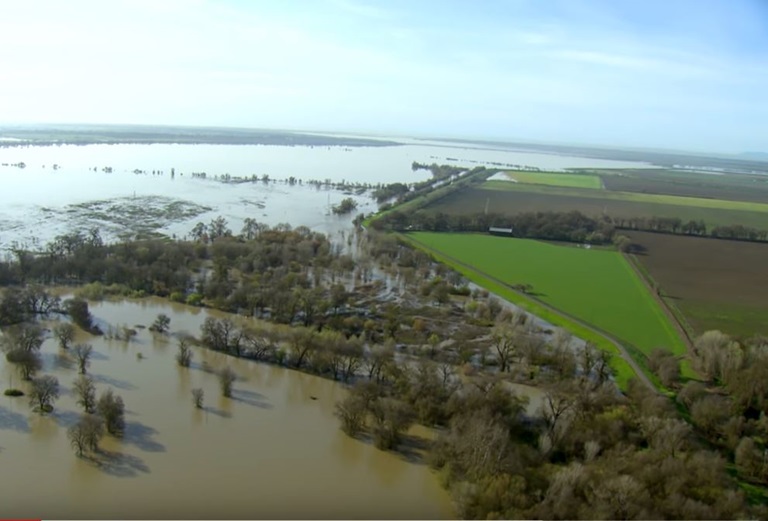Update on Fremont Weir Adult Fish Passage Modification Project
An aerial view of the Fremont Weir.
The Department of Water Resources (DWR) in partnership with the U.S. Bureau of Reclamation and in coordination with California Department of Fish and Wildlife has begun launching a new, first-of-its kind structure for California that aims to address a long-standing conflict between infrastructure and ecosystems.
The Fremont Weir Adult Fish Passage Modification Project provides a new channel to minimize fish stranding.
“Without this project, endangered fish would continue to perish in large numbers each year, as they have since the Fremont Weir was constructed nearly a century ago,” said DWR Deputy Director Kristopher Tjernell. “The structure will not prevent the stranding of every fish in the bypass but since its first use in January of 2019, it has already saved hundreds if not thousands of fish.”
The fish passage structure has remained an active construction project since it broke ground in spring 2018. To take advantage of heavy precipitation this year that caused overtopping of the Fremont Weir, DWR and CDFW jointly decided to begin operating the structure, allowing adult fish to reach the Sacramento River. The project passed fish as intended, but DWR staff also noticed erosion at the water channel below the base of the south side of the weir. The ground eroded where the concrete met the channel, pushing rocks down the channel.
Prolonged use of the fish passage gate amid the erosion could have eventually threatened the integrity of the infrastructure, shutting down operations for months if not years. This outcome would have raised project costs and resulted in significant fish strandings. In February, DWR began modifying operations of the facility, reducing flows through the passage, to minimize risk to the infrastructure. This modified schedule closed the fish passageway gates during times of high-velocity water flow. Unfortunately, some fish were stranded and perished from an overtopping event that started in late March. Included were a small number of Chinook, white sturgeon and striped bass. The fish were discovered on the weekend of April 20-21. As of April 25, the passageway was reopened under the modified schedule and hundreds of fish have successfully passed through to the Sacramento River.
‘While no infrastructure can save every fish from stranding, this important project will save the lives of countless endangered fish,” said Stafford Lehr, CDFW Deputy Director of the Wildlife and Fisheries Division. “For those fish that are still unable to make it through, we have a robust fish rescue program and will continue to coordinate with DWR.”
As weather continues to warm this year, DWR will return the rocks from downstream to the base of the structure. Construction teams will introduce bigger rocks that resist fast-moving water at the base of the facility, and fill the gaps between the rocks with a slurry or viscous material that hardens the rocks in place. This process will bolster the integrity of the infrastructure while providing a natural habitat for fish species. Work will begin over the summer and is targeted to be completed by November to have the fish passage structure fully operable for the next winter.
As with all new projects, it’s important to adjust the design and operations to address real-world considerations that weren’t apparent in the conceptual design and modeling. The state continues to learn and adapt as it uses this new facility and these lessons will inform the design and construction of other similar projects planned across the state.
